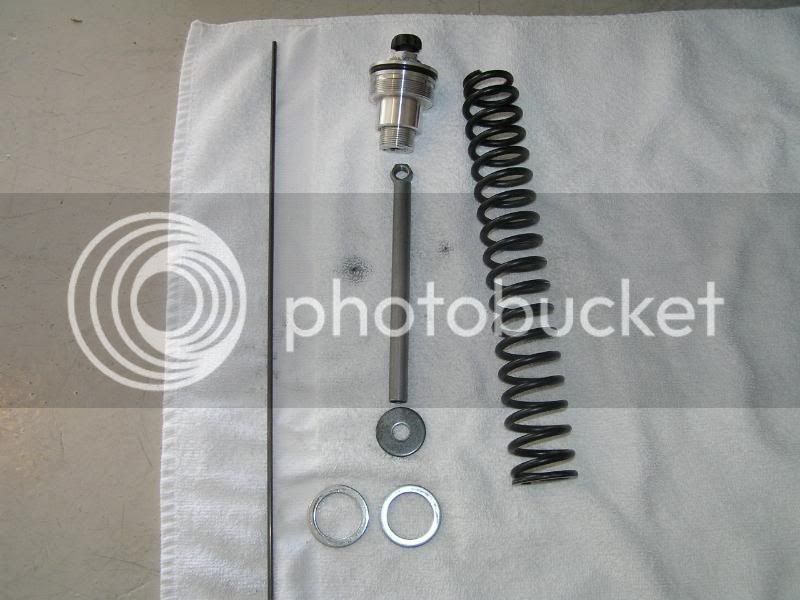SkooterG
Purveyor of Crooked Facts
Fork maintenance day today. Flush out the old nasty fluid, and in with the new. During the process I ran into a couple of issues I could use some advice or help with.
Background: 219k miles on the forks. 47k miles since the last service when TWN's GP Suspension valves and springs were installed by a shop.
So, I removed fork caps, nut, spacer rod, and washer. Spring is then removed. Fork is inverted and out comes another washer. On the right fork, one washer comes out. On the left fork, TWO of these washers come out. WTF?!?!
I am assuming these are stock parts, and that the GP Suspension upgrade was only valves and springs. So how did this shop manage to add an additional (and identical) washer to the one fork? Doesn't make me feel real good about their work. According to the service manual, this bottom washer is the 'spring seat' and there is only supposed to be one.
Below is a photo of the let fork internals that I removed. The 'two' washers in question are at the bottom of the photo.

Can anybody provide any enlightening information here?
Guess it wasn't the worst thing, but I guess the fork with the extra washer, or spring seat had some extra preload due to the extra washer. Still pisses me off that a suspension shop wold make such an error, however.
Second issue. A couple months back, I think I began to notice some fork travel irregularites while taking the bike off the centerstand. It seemed as though when taking the FJR off the C-stand, as the forks would compress and then rebound, the travel would not be smooth, but a bit jerky. I remember thinking, 'I need to service the forks'!
Well, I found the problem, sort of, but wonder what's going on.
After draining the fluid, I was excercising the fork dampening rod up and down. Smooth action on the left fork, but there is all kinds of uneven resistance on the right fork. Inner tube and outer tube travel is fine on both. Bushings are only for the inner and outer tube, correct? So they aren't the issue. Dampening rod has to do with the valving, right? So what could be wrong the internal valving parts, or tube, that there is all kinds of resistance there? Anybody?
I am not disassembling the forks any further. No knowledge or proper tools. So I guess now they are going to a shop.
Background: 219k miles on the forks. 47k miles since the last service when TWN's GP Suspension valves and springs were installed by a shop.
So, I removed fork caps, nut, spacer rod, and washer. Spring is then removed. Fork is inverted and out comes another washer. On the right fork, one washer comes out. On the left fork, TWO of these washers come out. WTF?!?!
I am assuming these are stock parts, and that the GP Suspension upgrade was only valves and springs. So how did this shop manage to add an additional (and identical) washer to the one fork? Doesn't make me feel real good about their work. According to the service manual, this bottom washer is the 'spring seat' and there is only supposed to be one.
Below is a photo of the let fork internals that I removed. The 'two' washers in question are at the bottom of the photo.

Can anybody provide any enlightening information here?
Guess it wasn't the worst thing, but I guess the fork with the extra washer, or spring seat had some extra preload due to the extra washer. Still pisses me off that a suspension shop wold make such an error, however.
Second issue. A couple months back, I think I began to notice some fork travel irregularites while taking the bike off the centerstand. It seemed as though when taking the FJR off the C-stand, as the forks would compress and then rebound, the travel would not be smooth, but a bit jerky. I remember thinking, 'I need to service the forks'!
Well, I found the problem, sort of, but wonder what's going on.
After draining the fluid, I was excercising the fork dampening rod up and down. Smooth action on the left fork, but there is all kinds of uneven resistance on the right fork. Inner tube and outer tube travel is fine on both. Bushings are only for the inner and outer tube, correct? So they aren't the issue. Dampening rod has to do with the valving, right? So what could be wrong the internal valving parts, or tube, that there is all kinds of resistance there? Anybody?
I am not disassembling the forks any further. No knowledge or proper tools. So I guess now they are going to a shop.




















































